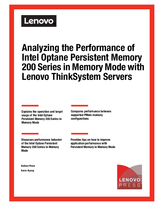Authors
Published
23 Sep 2021Form Number
LP1528PDF size
17 pages, 245 KBAbstract
The conventional system memory tiering consists of several levels of processor caches, a main memory tier with DDR memory DIMMs, and a system storage tier. In this tiering model, there is a large gap in performance and cost between the main memory tier and system storage tier. Intel Optane Persistent Memory (PMem) was brought to the market to help address this gap.
Intel Optane Persistent Memory 200 Series supports two modes, Memory Mode and App Direct Mode. In Memory Mode, the regular DRAM system memory acts as the next level cache, and the PMem becomes the system main memory. This enables the system to have higher system memory capacity and/or lower TCO. It doesn’t require any changes to applications.
In this performance brief, we first explain the operations and the important performance metrics of the PMem 200 Series in Memory Mode. We will then discuss and explain the performance comparison between a few supported memory configurations with PMem. We will end the discussion with a few tips on how to configure system memory with PMem in Memory Mode to maximize system memory and application performance.
This performance brief is for customers, business partners and sellers who wish to have a better understanding on the performance behavior and to learn how to better configure the memory subsystem for performance with Intel Optane Persistent Memory 200 Series in Memory Mode. It is expected that the reader will have a basic understanding on system memory hierarchy, data cache operations, and memory performance.
Table of Contents
Introduction
Memory Population with PMem
DRAM and PMem size ratios
Performance evaluation test methodology and setup
Memory bandwidth performance
Memory latency performance
Summary
To view the document, click the Download PDF button.
Configure and Buy
Full Change History
Course Detail
Employees Only Content
The content in this document with a is only visible to employees who are logged in. Logon using your Lenovo ITcode and password via Lenovo single-signon (SSO).
The author of the document has determined that this content is classified as Lenovo Internal and should not be normally be made available to people who are not employees or contractors. This includes partners, customers, and competitors. The reasons may vary and you should reach out to the authors of the document for clarification, if needed. Be cautious about sharing this content with others as it may contain sensitive information.
Any visitor to the Lenovo Press web site who is not logged on will not be able to see this employee-only content. This content is excluded from search engine indexes and will not appear in any search results.
For all users, including logged-in employees, this employee-only content does not appear in the PDF version of this document.
This functionality is cookie based. The web site will normally remember your login state between browser sessions, however, if you clear cookies at the end of a session or work in an Incognito/Private browser window, then you will need to log in each time.
If you have any questions about this feature of the Lenovo Press web, please email David Watts at dwatts@lenovo.com.

